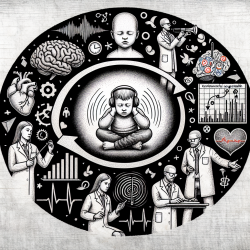Introduction
In the bustling environments of schools and urban settings, noise is an omnipresent factor. As practitioners in speech-language pathology, understanding the impact of environmental noise on children's health is crucial. The recent systematic review and meta-analysis titled "Impact of Noise Exposure on Risk of Developing Stress-Related Health Effects Related to the Cardiovascular System" sheds light on this critical issue.
Key Findings from the Research
The systematic review examined the effects of noise exposure on cardiovascular biomarkers, including blood pressure, hypertension, and heart rate. The findings suggest that exposure to higher noise levels may increase the risk of cardiovascular events. However, the certainty of this evidence remains very low due to inconsistencies across studies and populations.
- Blood Pressure: The meta-analysis indicated potential signals of increased blood pressure in response to higher noise levels, particularly in children. However, the evidence was inconsistent and varied across different noise sources.
- Hypertension: There was a suggestion of increased risk of hypertension with higher noise exposure, but again, the evidence was not robust enough to draw definitive conclusions.
- Heart Rate: Similar trends were observed with heart rate, where higher noise exposure was associated with increased heart rate, albeit with very low certainty.
Implications for Practitioners
As practitioners dedicated to improving child health outcomes, these findings underscore the importance of considering environmental noise in our therapeutic and educational settings. Here are some actionable steps to integrate these insights into practice:
- Noise Assessment: Regularly assess the noise levels in therapy and classroom settings. Use sound level meters to ensure environments are conducive to learning and communication.
- Noise Mitigation Strategies: Implement noise reduction strategies such as soundproofing, using white noise machines, or scheduling quiet periods during the day.
- Educate and Advocate: Educate school staff and parents about the potential impacts of noise on children's health and advocate for policies that promote quieter learning environments.
Encouraging Further Research
The review highlights the need for more research to better understand the relationship between noise exposure and cardiovascular health. Practitioners can contribute by:
- Participating in Research: Collaborate with researchers to study the effects of noise in educational settings.
- Data Collection: Collect and share data on noise levels and child health outcomes to support larger research initiatives.
Conclusion
While the current evidence on noise exposure and cardiovascular health is not definitive, it provides a foundation for practitioners to take proactive steps in creating healthier environments for children. By integrating noise assessment and mitigation strategies into our practices, we can help reduce stress-related health effects and promote better outcomes for the children we serve.
To read the original research paper, please follow this link: Impact of Noise Exposure on Risk of Developing Stress-Related Health Effects Related to the Cardiovascular System: A Systematic Review and Meta-Analysis.










